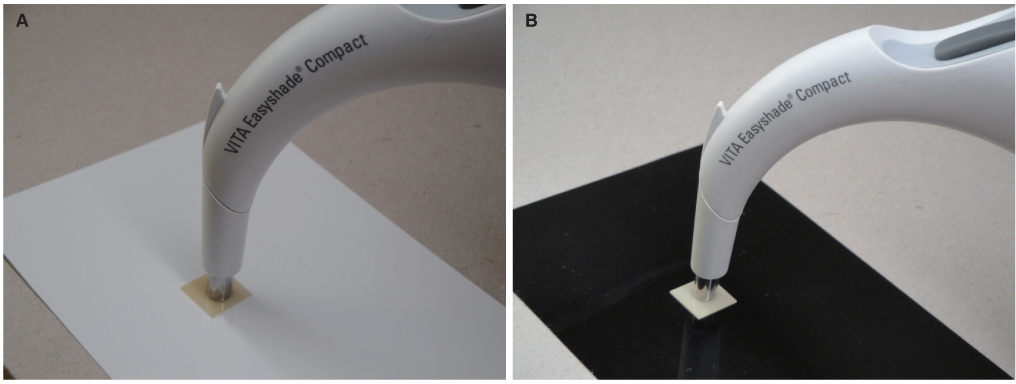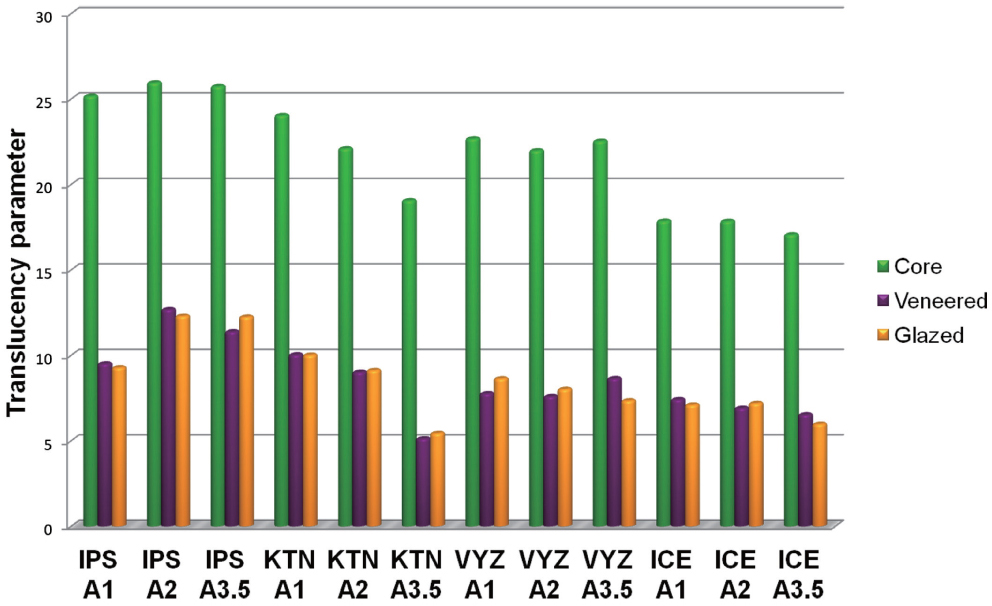J Adv Prosthodont.
2014 Oct;6(5):415-422. 10.4047/jap.2014.6.5.415.
Comparison of the translucency of shaded zirconia all-ceramic systems
- Affiliations
-
- 1Department of Prosthodontics, Faculty of Dentistry, Near East University, Mersin10, Turkey. sevcankurtulmusyilmaz@gmail.com
- KMID: 2284742
- DOI: http://doi.org/10.4047/jap.2014.6.5.415
Abstract
- PURPOSE
The purpose of this study was to evaluate and compare the translucency of shaded zirconia all-ceramic systems.
MATERIALS AND METHODS
Translucency of 3 different zirconia all-ceramic systems colored by different techniques was compared with a lithium disilicate glass-ceramic (IPS e.max Press). Square-shaped specimens with 0.5 mm thickness were fabricated from In-Ceram YZ, ICE Zirkon and Katana systems in A1, A2 and A3.5 shades according to Vitapan Classical shade tab (n=11). Specimens were then veneered and glazed with corresponding veneer ceramic recommended by each zirconia system manufacturer and the total thickness was set to 1.5 mm. Translucency measurements were performed with VITA Easyshade Compact spectrophotometer after each stage and translucency parameter was calculated. Data were statistically analyzed with repeated measures ANOVA and Tukey multiple comparison test.
RESULTS
The control group was significantly more translucent than the zirconia systems (P<.05). ICE Zirkon cores showed the least translucency; neither In-Ceram YZ nor Katana systems were superior to each other in terms of translucency. Translucency of all specimens was decreased after veneering, and the translucency rankings were changed.
CONCLUSION
Coloring technique did not have a significant effect on translucency of zirconia cores. Although zirconia systems were less translucent than lithium disilicate glass ceramic, they had partial translucency and there were translucency differences among the zirconia systems. Chroma affected the translucency of precolored zirconia cores.
Keyword
Figure
Cited by 3 articles
-
Comparative color and surface parameters of current esthetic restorative CAD/CAM materials
Ferhan Egilmez, Gulfem Ergun, Isil Cekic-Nagas, Pekka Kalevi Vallittu, Lippo Veli Juhana Lassila
J Adv Prosthodont. 2018;10(1):32-42. doi: 10.4047/jap.2018.10.1.32.Color changes of ceramic veneers following glazing with respect to their composition
Sung-Joon Kim, Jae-Man Woo, Chan Woo Jo, Ju-Hee Park, Soo Kyung Kim, Se Hoon Kahm
J Adv Prosthodont. 2019;11(1):16-22. doi: 10.4047/jap.2019.11.1.16.Evaluation of translucency of monolithic zirconia and framework zirconia materials
İlkin Tuncel, Işıl Turp, Aslıhan Üşümez
J Adv Prosthodont. 2016;8(3):181-186. doi: 10.4047/jap.2016.8.3.181.
Reference
-
1. Rosenstiel SF, Land MF, Fujimoto J. Contemporary fixed prosthodontics. St. Louis, Mo: Mosby Elsevier;2006. p. 774.2. Raptis NV, Michalakis KX, Hirayama H. Optical behavior of current ceramic systems. Int J Periodontics Restorative Dent. 2006; 26:31–41.3. Raigrodski AJ. Contemporary materials and technologies for all-ceramic fixed partial dentures: a review of the literature. J Prosthet Dent. 2004; 92:557–562.4. Conrad HJ, Seong WJ, Pesun IJ. Current ceramic materials and systems with clinical recommendations: a systematic review. J Prosthet Dent. 2007; 98:389–404.5. Kelly JR, Nishimura I, Campbell SD. Ceramics in dentistry: historical roots and current perspectives. J Prosthet Dent. 1996; 75:18–32.6. Denry I, Kelly JR. State of the art of zirconia for dental applications. Dent Mater. 2008; 24:299–307.7. Aboushelib MN, de Jager N, Kleverlaan CJ, Feilzer AJ. Microtensile bond strength of different components of core veneered all-ceramic restorations. Dent Mater. 2005; 21:984–991.8. Holloway JA, Miller RB. The effect of core translucency on the aesthetics of all-ceramic restorations. Pract Periodontics Aesthet Dent. 1997; 9:567–574. quiz 576.9. Jiang L, Liao Y, Wan Q, Li W. Effects of sintering temperature and particle size on the translucency of zirconium dioxide dental ceramic. J Mater Sci Mater Med. 2011; 22:2429–2435.10. Heffernan MJ, Aquilino SA, Diaz-Arnold AM, Haselton DR, Stanford CM, Vargas MA. Relative translucency of six all-ceramic systems. Part I: core materials. J Prosthet Dent. 2002; 88:4–9.11. Chen YM, Smales RJ, Yip KH, Sung WJ. Translucency and biaxial flexural strength of four ceramic core materials. Dent Mater. 2008; 24:1506–1511.12. Aboushelib MN, Kleverlaan CJ, Feilzer AJ. Effect of zirconia type on its bond strength with different veneer ceramics. J Prosthodont. 2008; 17:401–408.13. Baldissara P, Llukacej A, Ciocca L, Valandro FL, Scotti R. Translucency of zirconia copings made with different CAD/CAM systems. J Prosthet Dent. 2010; 104:6–12.14. Manicone PF, Rossi Iommetti P, Raffaelli L. An overview of zirconia ceramics: basic properties and clinical applications. J Dent. 2007; 35:819–826.15. Shah K, Holloway JA, Denry IL. Effect of coloring with various metal oxides on the microstructure, color, and flexural strength of 3Y-TZP. J Biomed Mater Res B Appl Biomater. 2008; 87:329–337.16. Hjerppe J, Närhi T, Fröberg K, Vallittu PK, Lassila LV. Effect of shading the zirconia framework on biaxial strength and surface microhardness. Acta Odontol Scand. 2008; 66:262–267.17. Kulkarni NK, Sampath S, Venugopal V. Studies on stabilised zirconia as host phase for the fixation of actinides, rareearths and sodium. Ceram Int. 2001; 27:839–846.18. Pittayachawan P, McDonald A, Petrie A, Knowles JC. The biaxial flexural strength and fatigue property of Lava Y-TZP dental ceramic. Dent Mater. 2007; 23:1018–1029.19. Spyropoulou PE, Giroux EC, Razzoog ME, Duff RE. Translucency of shaded zirconia core material. J Prosthet Dent. 2011; 105:304–307.20. Pecho OE, Ghinea R, Ionescu AM, CardonaJde L, Paravina RD, Pérez Mdel M. Color and translucency of zirconia ceramics, human dentine and bovine dentine. J Dent. 2012; 40:e34–e40.21. Tuncel I, Eroglu E, Sari T, Usumez A. The effect of coloring liquids on the translucency of zirconia framework. J Adv Prosthodont. 2013; 5:448–451.22. Johnston WM, Ma T, Kienle BH. Translucency parameter of colorants for maxillofacial prostheses. Int J Prosthodont. 1995; 8:79–86.23. Lim HN, Yu B, Lee YK. Spectroradiometric and spectrophotometric translucency of ceramic materials. J Prosthet Dent. 2010; 104:239–246.24. Ahn JS, Lee YK. Difference in the translucency of all-ceramics by the illuminant. Dent Mater. 2008; 24:1539–1544.25. Kurtulmus-Yilmaz S, Cengiz E, Ulusoy N, Ozak ST, Yuksel E. The effect of home-bleaching application on the color and translucency of five resin composites. J Dent. 2013; 41:e70–e75.26. Spink LS, Rungruanganut P, Megremis S, Kelly JR. Comparison of an absolute and surrogate measure of relative translucency in dental ceramics. Dent Mater. 2013; 29:702–707.27. Kim MJ, Ahn JS, Kim JH, Kim HY, Kim WC. Effects of the sintering conditions of dental zirconia ceramics on the grain size and translucency. J Adv Prosthodont. 2013; 5:161–166.28. Bolt RA, Bosch JJ, Coops JC. Influence of window size in small-window colour measurement, particularly of teeth. Phys Med Biol. 1994; 39:1133–1142.29. Kumagai N, Hirayama H, Finkelman MD, Ishikawa-Nagai S. The effect of translucency of Y-TZP based all-ceramic crowns fabricated with difference substructure designs. J Dent. 2013; 41:e87–e92.30. Heffernan MJ, Aquilino SA, Diaz-Arnold AM, Haselton DR, Stanford CM, Vargas MA. Relative translucency of six all-ceramic systems. Part II: core and veneer materials. J Prosthet Dent. 2002; 88:10–15.31. Ilie N, Hickel R. Correlation between ceramics translucency and polymerization efficiency through ceramics. Dent Mater. 2008; 24:908–914.
- Full Text Links
- Actions
-
Cited
- CITED
-
- Close
- Share
- Similar articles
-
- The effect of coloring liquids on the translucency of zirconia framework
- Evaluation of translucency of monolithic zirconia and framework zirconia materials
- Esthetic anterior restoration using 3M Lavaâ„¢ Esthetic monolithic zirconia
- Comparative analysis of transmittance for different types of commercially available zirconia and lithium disilicate materials
- Polish of interface areas between zirconia, silicate-ceramic, and composite with diamond-containing systems




